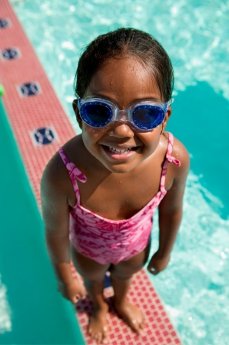
By Stephanie Simons,
Head Pharmacist,
Lindo’s Pharmacy in Devonshire
With the increasing number of displays of notebooks, pencils, back packs and lunch bags popping up across stores in Bermuda, a not so subtle hint reminds parents and students alike that a new school year is approaching. While preparing a list for back to school shopping, you may want to consider one additional task — scheduling a routine eye exam for your child.
Most educational environments are structured to support visual learning, engaging students to learn through watching demonstrations, reading books, using the computer, interpreting pictures they see and engaging with visual materials. Eye health is certainly a consideration in this environment! Healthy eyes also help children to actively participate in sports and other extra-curricular activities.
The UK National Screening Committee recommends screening children between the ages of four and five for visual impairments. Likewise, the American Optometric Association encourages parents to schedule a comprehensive eye exam for their children at age three, then again before starting school.
Common Symptoms of Eye Problems
Parents and caregivers can be on the lookout for several common symptoms affecting vision in young children, including:
- chronic redness or tearing
- routinely sitting too close to a television or holding a book very close to his or her face
- favouring one eye over the other
- a wandering eye
- tilting or turning his or her head to look at objects
- holding objects at a great distance
- frequently squinting or rubbing his or her eyes
A number of factors contribute to overall eye health, from a healthy environment and balanced food choices, to wearing protective eye gear during sports and outdoor activities.
Common Irritations
Eye discomfort is a common complaint following children swimming in the ocean or in a pool treated with chlorine. Red or itchy eyes may also be the result of allergies, or sand or dust getting into their eyes. Parents can ease their child’s discomfort by rinsing their eyes with lukewarm water from a tap or jug or eyewash like Optrex, or using an artificial tear solution made from pure saline. To prevent irritation during swimming, wearing goggles will often suffice, and provide the fun benefit of seeing what is on the ocean or pool floor!
If an object gets lodged in a child’s eye, such as a glass shard or splinter, parents should seek immediate help from a trained health professional. Attempting to remove this type of debris could result in damage to the eye, especially the cornea.
 Protecting Vision
Protecting Vision
Protective eye gear made from polycarbonate, a highly impact-resistant plastic, makes many sports and activities safer for our children’s eyes. If your child participates in a sport involving a ball, stick, racket, puck or other projectile object, you may want to consider investing in this eye gear.
Sunglasses afford eye protection from harmful UVA and UVB rays that can damage the eyelid, lens and cornea, sometimes leading to the development of cataracts. When purchasing new shades, look for a label that indicates they block 99-100% of UVA and UVB rays and ensure they properly fit your child.
Eye injuries can also be prevented by keeping chemicals out of reach of children, especially fertilizers, pool chemicals, cleaning agents and pesticides.
Healthy Eating
When it comes time for snacks and meals, providing your child with a diet rich in fruits, vegetables and legumes will have a positive impact on their eye health.
When packing their lunch boxes, consider adding dark, leafy greens (kale, spinach, collard greens), which are high in lutein and zeaxanthin, and may lower the risk of age related macular degeneration and cataracts. Foods such as salmon, tuna, halibut and sardines contain Omega-3 fatty acids, and can reduce the risk of eye diseases later in life. If your child isn’t a fan of fish, many Omega-3 vitamin supplements are on the market. Foods high in zinc can protect from the damaging effects of light, and is easily sourced in black eyed peas, kidney beans, lima beans and peanuts. Citrus fruits, often a crowd pleaser with children, contain antioxidants, and also benefit our eyes.
When shopping for back to school supplies, consider a reusable water canteen. Just like the rest of our body, our eyes depend on hydration. Drinking an adequate amount of water will help produce tears, preventing dry eyes and allowing for debris to be washed away as we blink.
Preventing tears caused by the return to school, however, is a whole other article!
Stephanie Simons is the head pharmacist at Lindo’s Pharmacy in Devonshire. She earned her Bachelor of Science in Pharmacy at Massachusetts College of Pharmacy and has been practicing for over 20 years. She is a registered pharmacist with the Bermuda Pharmacy Council and is a member of the Bermuda Pharmaceutical Association.


